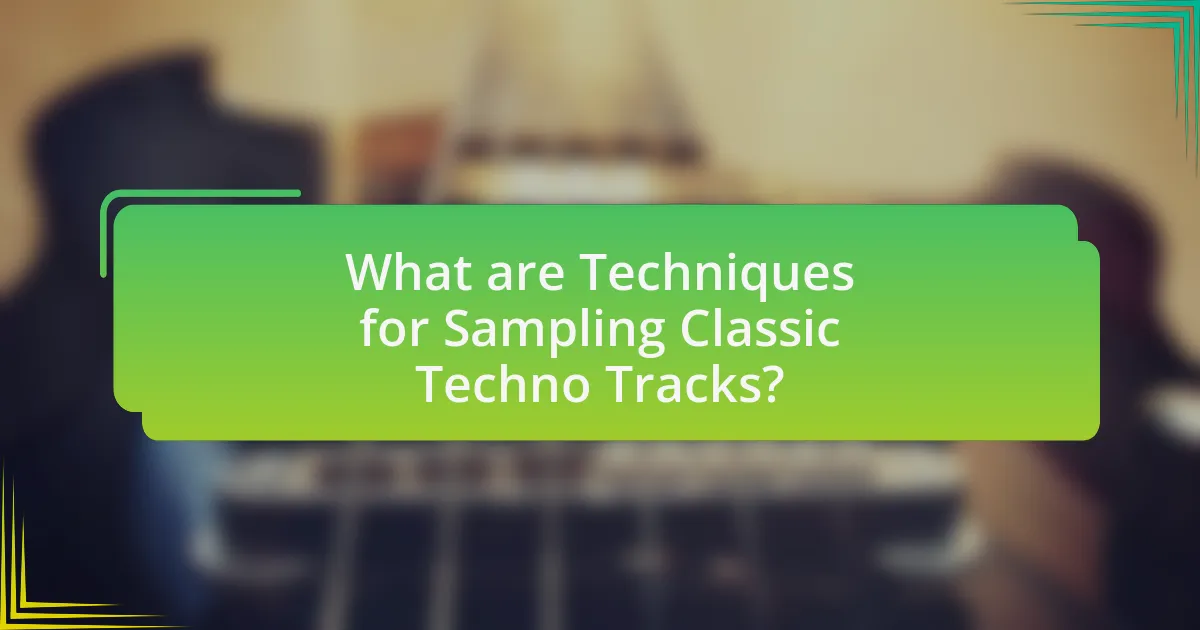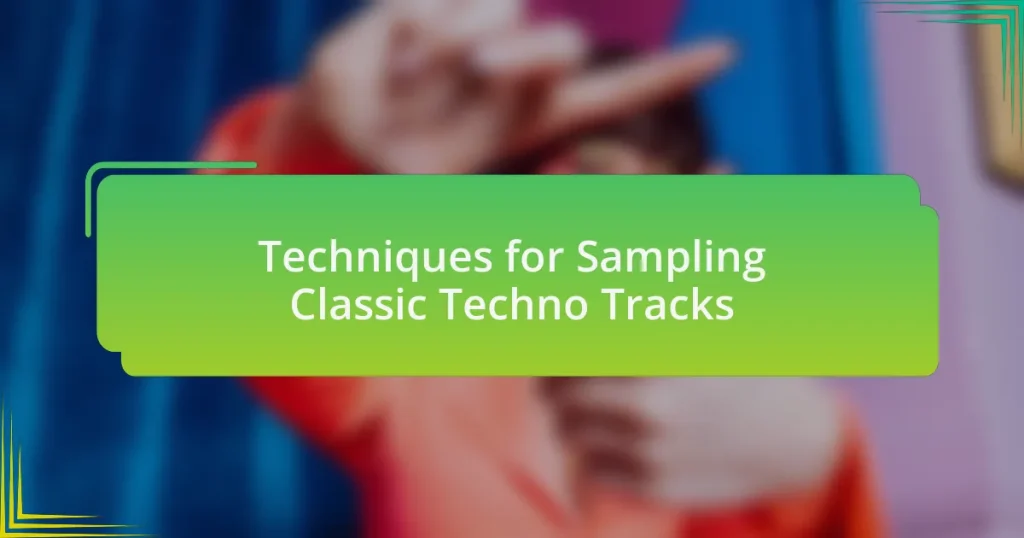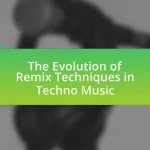The article focuses on techniques for sampling classic techno tracks, detailing methods such as hardware samplers, digital audio workstations (DAWs), and vinyl sampling. It explores how these techniques enhance the genre by incorporating diverse sounds and textures, while also discussing key elements that can be sampled, including drum patterns, basslines, and synth melodies. Additionally, the article addresses the legal implications of sampling, best practices for producers, and the evolving role of technology and AI in sampling techniques. Overall, it provides a comprehensive overview of the tools, methods, and considerations essential for effectively sampling classic techno music.

What are Techniques for Sampling Classic Techno Tracks?
Techniques for sampling classic techno tracks include using hardware samplers, digital audio workstations (DAWs), and vinyl sampling. Hardware samplers like the Akai MPC series allow for real-time manipulation of samples, enabling producers to create unique sounds. DAWs, such as Ableton Live and FL Studio, offer extensive tools for slicing, rearranging, and processing samples, which enhances creativity and flexibility in production. Vinyl sampling involves extracting sounds from classic records, providing an authentic texture and warmth that digital sources may lack. This technique often requires a turntable and a high-quality audio interface to capture the nuances of the original recordings. These methods are widely used in the techno genre to create innovative tracks while paying homage to classic sounds.
How do sampling techniques enhance classic techno music?
Sampling techniques enhance classic techno music by allowing producers to incorporate diverse sounds and textures, creating a richer auditory experience. These techniques enable the manipulation of existing audio recordings, which can include snippets from other genres, vocal samples, or instrumental loops, thus adding layers of complexity and innovation to the music. For instance, the use of samples from funk, jazz, or even film scores can introduce unique rhythmic patterns and melodic elements that are not typically found in traditional techno. This practice not only pays homage to the original works but also fosters creativity and experimentation within the genre, as evidenced by the widespread use of samples in iconic tracks from artists like Derrick May and Carl Craig, who have shaped the sound of techno through their innovative sampling methods.
What are the key elements of classic techno tracks that can be sampled?
The key elements of classic techno tracks that can be sampled include drum patterns, basslines, synth melodies, vocal snippets, and atmospheric effects. Drum patterns, characterized by repetitive kick drums and hi-hats, form the backbone of techno and can be looped or manipulated. Basslines, often deep and driving, provide rhythmic support and can be sampled for their groove. Synth melodies, which are typically minimalistic and hypnotic, can be extracted to create new musical phrases. Vocal snippets, frequently processed and altered, add texture and can be used to enhance the track’s emotional impact. Atmospheric effects, such as reverb and delay, contribute to the overall soundscape and can be sampled to create immersive environments. These elements are foundational in classic techno, making them ideal for sampling in new productions.
How does sampling influence the overall sound and feel of a track?
Sampling significantly influences the overall sound and feel of a track by incorporating pre-existing audio elements that can evoke nostalgia, create unique textures, and establish a specific atmosphere. In techno music, sampling allows producers to blend various sonic characteristics, such as rhythm, melody, and timbre, from different sources, which can enhance the emotional depth and complexity of the track. For instance, the use of samples from classic tracks can connect contemporary music to its historical roots, fostering a sense of continuity and cultural relevance. Additionally, the manipulation of samples—through techniques like looping, pitch shifting, and effects processing—can transform the original sound, making it integral to the new composition while still retaining its recognizable essence. This practice is evident in the works of influential techno artists who often sample iconic sounds to create innovative and immersive listening experiences.
What types of sampling techniques are commonly used in classic techno?
Classic techno commonly utilizes techniques such as loop sampling, one-shot sampling, and pitch-shifting. Loop sampling involves taking a short segment of sound and repeating it to create rhythmic patterns, which is foundational in techno music. One-shot sampling refers to using a single sound or phrase, often from drum machines or synthesizers, to create distinct beats or effects. Pitch-shifting alters the frequency of a sound, allowing producers to manipulate samples to fit the desired key or mood of a track. These techniques have been integral in shaping the sound of classic techno, as evidenced by their widespread use in tracks from influential artists like Derrick May and Juan Atkins, who pioneered these methods in the genre’s early days.
What is the difference between loop-based and one-shot sampling?
Loop-based sampling involves creating a continuous loop from a segment of audio, allowing for repetitive playback, which is often used to build layers in a track. In contrast, one-shot sampling refers to triggering a single audio sample once, without repetition, typically used for specific sound effects or hits in a composition. The distinction lies in the playback method: loop-based sampling emphasizes repetition for rhythmic continuity, while one-shot sampling focuses on individual, distinct sounds.
How can pitch shifting and time stretching be applied in sampling?
Pitch shifting and time stretching can be applied in sampling to manipulate audio samples without altering their original quality. Pitch shifting allows producers to change the pitch of a sample, enabling them to match the key of a track or create harmonic variations, while time stretching enables the adjustment of the sample’s duration without affecting its pitch, allowing for seamless integration into different tempos. These techniques are essential in electronic music production, particularly in classic techno, where maintaining the integrity of the original sound while adapting it to new contexts is crucial. For instance, software like Ableton Live and Logic Pro provides advanced algorithms for pitch shifting and time stretching, ensuring high fidelity and musicality in the sampled material.
Why is it important to understand the legal aspects of sampling?
Understanding the legal aspects of sampling is crucial because it helps avoid copyright infringement and potential legal disputes. Sampling involves using portions of existing music, which can lead to legal issues if the original work is not properly licensed. For instance, the U.S. Copyright Act protects original works, and unauthorized use can result in lawsuits or financial penalties. Additionally, understanding these legalities enables artists to navigate the complexities of music rights, ensuring they can use samples legally and ethically while also protecting their own creative output.
What are the copyright implications of sampling classic techno tracks?
Sampling classic techno tracks without permission can lead to copyright infringement, as the original tracks are protected under copyright law. When a producer samples a portion of a classic techno track, they must obtain a license from the copyright holder, which typically includes both the sound recording and the underlying composition rights. Failure to do so can result in legal action, including lawsuits and financial penalties. For instance, the case of “Blurred Lines” highlighted the risks of unauthorized sampling, where the artists faced significant damages for copyright infringement. Therefore, it is essential for producers to navigate copyright laws carefully when sampling classic techno tracks to avoid legal repercussions.
How can artists navigate licensing issues when sampling?
Artists can navigate licensing issues when sampling by obtaining permission from the original copyright holders and ensuring compliance with copyright laws. This process typically involves contacting the rights holders, which may include record labels, publishers, or the artists themselves, to negotiate a licensing agreement that outlines the terms of use for the sampled material. According to the U.S. Copyright Office, sampling without permission can lead to legal disputes and financial penalties, emphasizing the importance of securing proper licenses before using any copyrighted material. Additionally, artists can explore using royalty-free samples or public domain works to avoid licensing complications altogether.
How can producers effectively sample classic techno tracks?
Producers can effectively sample classic techno tracks by utilizing high-quality audio extraction tools and ensuring they have the necessary rights to use the samples. High-quality audio extraction tools, such as digital audio workstations (DAWs) with advanced sampling capabilities, allow producers to isolate and manipulate specific elements from classic tracks. Additionally, obtaining the necessary rights is crucial, as unauthorized sampling can lead to legal issues; for instance, many classic techno tracks are protected under copyright law, which requires producers to seek permission or licenses for use. This approach not only respects the original artists but also enhances the producer’s credibility in the music industry.
What tools and software are best for sampling classic techno?
The best tools and software for sampling classic techno include Ableton Live, Native Instruments Maschine, and Akai MPC series. Ableton Live is renowned for its intuitive interface and powerful sampling capabilities, allowing users to manipulate audio clips seamlessly. Native Instruments Maschine combines hardware and software for beat-making and sampling, offering a wide range of sounds and effects tailored for electronic music. The Akai MPC series, particularly the MPC One and MPC Live, are iconic for their sampling prowess and have been used in classic techno production, providing hands-on control and a rich library of sounds. These tools are widely recognized in the music production community for their effectiveness in creating and sampling classic techno tracks.
How do different DAWs handle sampling techniques?
Different Digital Audio Workstations (DAWs) handle sampling techniques through varying features and functionalities tailored for audio manipulation. For instance, Ableton Live excels in its session view, allowing users to trigger samples in a non-linear fashion, which is ideal for live performances and improvisation. Logic Pro offers advanced flex time and pitch features, enabling precise editing of samples, while FL Studio provides a straightforward interface for slicing and rearranging samples using its built-in slicer tool. Pro Tools, known for its professional audio editing capabilities, allows for detailed sample manipulation through its audio suite plugins, ensuring high-quality sound processing. Each DAW’s unique approach to sampling reflects its design philosophy, catering to different user needs and workflows in music production.
What plugins can enhance the sampling process in classic techno production?
Plugins that can enhance the sampling process in classic techno production include Native Instruments Kontakt, Ableton Live’s Simpler, and Arturia’s Emulator II. Native Instruments Kontakt offers extensive sampling capabilities and a wide range of libraries, making it ideal for creating rich textures in techno tracks. Ableton Live’s Simpler allows for quick manipulation of samples with features like time-stretching and pitch-shifting, which are essential for achieving the desired sound. Arturia’s Emulator II emulates classic sampling hardware, providing authentic vintage sounds that are characteristic of classic techno. These plugins are widely recognized in the music production community for their effectiveness in enhancing sampling techniques.
What are some best practices for sampling classic techno tracks?
Best practices for sampling classic techno tracks include obtaining proper clearance for samples, ensuring the samples are high-quality and well-edited, and creatively manipulating the samples to fit the new context. Proper clearance is essential to avoid legal issues, as many classic techno tracks are protected by copyright. High-quality samples enhance the overall sound, while editing techniques such as time-stretching, pitch-shifting, and layering can create unique textures and rhythms that respect the original while adding a fresh perspective. These practices are supported by industry standards that emphasize the importance of originality and legal compliance in music production.
How can producers maintain the integrity of the original track while sampling?
Producers can maintain the integrity of the original track while sampling by using high-quality audio sources and ensuring that the sampled elements are processed minimally. High-quality audio sources preserve the nuances and characteristics of the original track, which is crucial for retaining its essence. Additionally, applying techniques such as time-stretching and pitch-shifting without altering the original sound’s timbre helps in keeping the sampled material true to its source. Research indicates that maintaining the original dynamics and frequency range of the sample contributes significantly to the authenticity of the final product, as seen in successful tracks that have sampled classic techno music.
What tips can help avoid common pitfalls in sampling classic techno?
To avoid common pitfalls in sampling classic techno, ensure that you have the proper licenses for any samples used. This is crucial because unauthorized sampling can lead to legal issues and financial penalties. Additionally, focus on maintaining the original vibe of the classic tracks while adding your unique elements, as this preserves the integrity of the genre. Lastly, be mindful of the technical aspects, such as tempo and key, to ensure that the samples blend seamlessly with your production. These practices are essential for creating respectful and legally sound techno music.
What are the future trends in sampling classic techno tracks?
Future trends in sampling classic techno tracks include the increased use of artificial intelligence and machine learning to analyze and recreate iconic sounds, as well as the integration of virtual reality environments for immersive sampling experiences. AI tools can dissect classic tracks to extract elements like beats and melodies, allowing producers to innovate while maintaining the essence of the originals. Additionally, the rise of decentralized music platforms is enabling artists to share and monetize their samples more effectively, fostering collaboration and creativity within the techno community. These trends reflect a shift towards technology-driven production methods that enhance accessibility and artistic expression in the genre.
How is technology evolving to change sampling techniques in music production?
Technology is evolving to change sampling techniques in music production through advancements in software, hardware, and artificial intelligence. Modern digital audio workstations (DAWs) now incorporate sophisticated sampling tools that allow producers to manipulate audio with unprecedented precision, enabling real-time pitch shifting, time stretching, and effects processing. For instance, software like Ableton Live and FL Studio offers features such as granular synthesis and advanced looping capabilities, which enhance the creative possibilities for sampling. Additionally, AI-driven tools like LANDR and iZotope’s RX can analyze and isolate samples from complex audio sources, making it easier for producers to extract and repurpose sounds from classic tracks. This evolution not only streamlines the sampling process but also expands the creative palette available to music producers, allowing for innovative reinterpretations of classic techno tracks.
What role does AI play in the future of sampling classic techno tracks?
AI plays a significant role in the future of sampling classic techno tracks by enhancing creativity and efficiency in music production. Through machine learning algorithms, AI can analyze vast libraries of classic techno music, identifying patterns, rhythms, and unique sound elements that can be sampled. This capability allows producers to create innovative remixes and original tracks that pay homage to classic sounds while introducing fresh elements. For instance, AI tools like OpenAI’s MuseNet and Google’s Magenta have demonstrated the ability to generate music that incorporates styles from various genres, including techno, thereby expanding the creative possibilities for artists.
What practical tips can enhance your sampling skills in classic techno?
To enhance your sampling skills in classic techno, focus on understanding the genre’s foundational elements, such as rhythm, texture, and sound selection. Familiarize yourself with classic tracks to identify key samples and techniques used by influential artists like Derrick May and Juan Atkins. Experiment with different sampling methods, including time-stretching and pitch-shifting, to manipulate sounds creatively. Utilize high-quality audio sources to ensure clarity and depth in your samples, as classic techno often relies on rich, layered sounds. Additionally, practice layering samples to create unique textures, which is a hallmark of the genre. Engaging with communities and forums dedicated to techno can provide valuable feedback and inspiration, further refining your skills.


